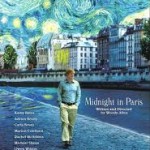 People have been talking about how much they like the new Woody Allen flick, Midnight in Paris.
People have been talking about how much they like the new Woody Allen flick, Midnight in Paris.
I think people seeing the film in San Francisco are going to appreciate Allen’s movie about the powerful hold that nostalgia has on our lives (a near-constant theme in Allen’s cannon) more than other audiences in cities around the world.
The reason for this is because of the many scenes in the movie devoted to Gertrude Stein’s Paris and the artists and writers that populate her world.
San Francisco is in the midst of a cultural celebration of Stein, with several institutions, including the San Francisco Museum of Modern Art, The Contemporary Jewish Museum and Yerba Buena Center for the Arts, all mounting exhibitions and other events devoted to the iconoclastic art patron and author.
I blogged about our city’s “Summer of Stein” a little while ago, here.
Having visited both the SFMOMA and CJM shows, it felt lovely and slightly surreal to see Picasso’s portrait of Stein and other iconic works created by the members of Stein’s clique in 1920s Paris that are currently hanging on the walls of San Francisco art institutions reproduced in the film.
The portrayal of Stein by Kathy Bates was both hilarious and sensitive. Watching the actress play the art doyenne on screen made the exhibitions about Stein currently unfolding in San Francisco come to life in an even more vivid way.
Midnight in Paris, and Bates’ rendition of Stein in particular, also made me think back to The Lost Generation, one of Allen’s wonderful early standup comedy routines. I guess that Stein — and nostalgia in general for 1920s Paris — has been with the filmmaker for a long time:
The Lost Generation
I mentioned before that I was in Europe. It’s not the first time that I was in Europe, I was in Europe many years ago with Ernest Hemingway. Hemingway had just written his first novel, and Gertrude Stein and I read it, and we said that is was a good novel, but not a great one, and that it needed some work, but it could be a fine book. And we laughed over it. Hemingway punched me in the mouth.
That winter Picasso lived on the Rue d’Barque, and he had just painted a picture of a naked dental hygenist in the middle of the Gobi Desert. Gertrude Stein said it was a good picture, but not a great one, and I said it could be a fine picture. We laughed over it and Hemingway punched me in the mouth.
Francis Scott and Zelda Fitzgerald came home from their wild new years eve party. It was April. Scott had just written Great Expectations, and Gertrude Stein and I read it, and we said it was a good book, but there was no need to have written it, ’cause Charles Dickens had already written it. We laughed over it, and Hemingway punched me in the mouth.
That winter we went to Spain to see Manolete fight, and he was… looked to be eighteen, and Gertrude Stein said no, he was nineteen, but that he only looked eighteen, and I said sometimes a boy of eighteen will look nineteen, whereas other times a nineteen year old can easily look eighteen. That’s the way it is with a true Spaniard. We laughed over that and Gertrude Stein punched me in the mouth.
Good night.











